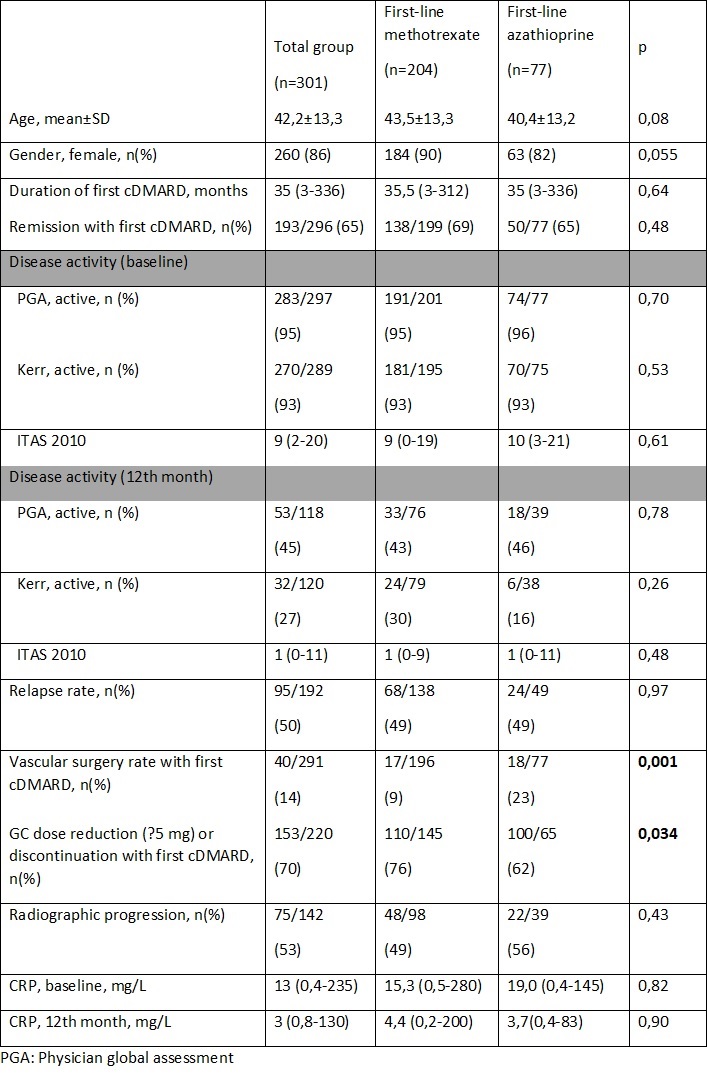Session Information
Date: Monday, November 13, 2023
Title: (1554–1578) Vasculitis – Non-ANCA-Associated & Related Disorders Poster II
Session Type: Poster Session B
Session Time: 9:00AM-11:00AM
Background/Purpose: Conventional disease-modifying anti-rheumatic drugs (cDMARDs) are recommended in addition to glucocorticoids (GC) for all active Takayasu’s arteritis (TAK) patients as the first-line therapy. However, there is limited data comparing cDMARDs as the first-line immunosuppressive (IS) treatment. In this study, we aimed to compare the outcomes of methotrexate (MTX) and azathioprine (AZA), which were used most frequently as the first-line cDMARDs, in TAK patients.
Methods: TAK patients who received cDMARDs in addition to GCs as the initial therapy were included in this multicenter retrospective cohort study. Clinical, laboratory and imaging data of the patients were assessed. In addition, a match analysis (cc match) using variables ‘age’, ‘gender’ and ‘diffuse aortic involvement’ was performed between patients who received MTX or AZA as first-line cDMARD treatment.
Results: We included 301 (F/M: 260/41, mean age: 42.2±13.3) patients from 10 centres in the study. As the first-line cDMARD, 204 (67.8%) patients received MTX and 77 (25.6%) patients received AZA. First cDMARD was cyclophosphamide in 17 (5.6%), leflunomide in 2 (0.5%) and mycophenolate mofetil in one patient. The remission, relapse and radiographic progression rates were similar between patients who received MTX and AZA as first-line cDMARDs. Vascular surgery rate was higher in the AZA (23% vs. 9%, p=0.001), whereas the frequency of patients receiving ≤5 mg/day GCs at the end of the follow-up was higher in the MTX group (76 vs 62%, p=0.034). Similarly, the rate of vascular surgery was higher and the GC dose reduction rate (≤5 mg) was lower in AZA group in match analysis. Drug survival was similar between MTX and AZA groups (median 48 months, MTX vs AZA: 32% vs 42%, p=0.34). IS therapy was discontinued in 18 (11 MTX, 7 AZA) patients during the follow-up period due to remission. In the IS discontinuation group 2 patients had a relapse at 2 and 6 months, while 16 patients were still on remission at the end of mean 69.4 (±50.9) months of follow-up.
Conclusion: Remission, relapse, radiographic progression and drug survival rates of azathioprine and methotrexate were similar in Takayasu’s arteritis patients having the first-line of therapy. The rate of vascular surgery was higher and the rate of steroid dose reduction was lower with azathioprine compared to methotrexate at the end of the follow-up.
To cite this abstract in AMA style:
Kaymaz-Tahra S, Bayindir Tsechelidis O, Ince B, Isik O, Kutu M, Karakas O, Demirci Yildirim T, Ademoglu Z, Durak Ediboglu E, Ekti Uludogan B, Ilgin C, Yasar Bilge S, Kasifoğlu T, Akar S, Emmungil H, Onen F, Omma A, Alpay Kanitez N, Yazici A, Cefle A, Inanç M, Aksu K, Keser G, Direskeneli H, Alibaz-Öner f. Comparison of Methotrexate and Azathioprine as the First Steroid-Sparing Immunosuppressive Agent in Patients with Takayasu’s Arteritis [abstract]. Arthritis Rheumatol. 2023; 75 (suppl 9). https://acrabstracts.org/abstract/comparison-of-methotrexate-and-azathioprine-as-the-first-steroid-sparing-immunosuppressive-agent-in-patients-with-takayasus-arteritis/. Accessed .« Back to ACR Convergence 2023
ACR Meeting Abstracts - https://acrabstracts.org/abstract/comparison-of-methotrexate-and-azathioprine-as-the-first-steroid-sparing-immunosuppressive-agent-in-patients-with-takayasus-arteritis/


